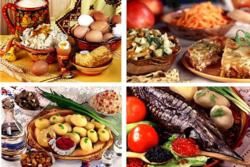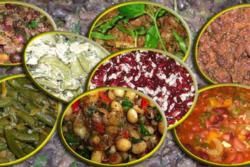Food and Drink
Introduction
Like many aspects of a trip to Russia, the quality and variety of the local cuisine is likely to come as a pleasant surprise for the visitor, and not only because of the preconceived notions and low expectations most visitors are likely to have. If you visited during Soviet times you will remember the thick creamy salads and lackless meat cutlets that were served at most restaurants, albeit accompanied with caviar and champagne to take some of the taste away. Things were much worse for the vast majority of the population for whom such goods were restricted to party functionaries or special occasions, and food shortages were an everday fact-of-life. Today it's not difficult to buy imported tropical fruits in mid-winter, or sea fish in shops thousands of miles from the nearest maritime coastline. The variety of local and imported foodstuffs available in shops and the quality and range of restaurants is on a par with anything in the rest of Europe, and for a while it was even claimed that more sushi was eaten per capita in Moscow than in Tokyo!
Since the collapse of the Soviet Union, a new generation of restaurateurs has rediscovered and reinvented some of the country's traditional dishes and ways of preparing food which regular shortages caused by central economic planning and a communist desire to eschew frivolities had all but eliminated. While you can still find borsch and beef stroganoff (regularly) and Chicken Kiev (occasionally) on the menu (together with sushi, which is ubiquitous and appears on menus at pizza restaurants, breweries, cafes, and other places where you'd never expect to see it), there is so much more to Russian cuisine than these stereotypical dishes, and the adventurous visitor can enjoy a wide range of national and regional dishes and drinks rarely available outside the country, and often available only on a seasonal basis. Many restaurants also include provide menus in English now too, so just ask for menyu po-angliyskii if you require one of these.
Russian cuisine
Traditional Russian cuisine is based around those fruits, vegetables, meats and milk products available in a northern geography, so you will find lots of dishes which include potatotes, beets, beans, mushrooms, onions, tomatoes, pulses, berries and so on. The rigours of the climate mean that many dishes are warming winter soups and stews, but there is also a large amount of seasonal variety, including cold soups and salads in summer (often covered in mayonnaise), and many restaurants and cafes also offer a Lent menu (known as post in Russian) in the run up to Christmas and Easter. St Petersburg's location on the Baltic should mean some great seafood options, although these are not as widely available as you might expect.
Soups
While vermillion-coloured borsch, served piping hot with a dollop of creamy mayonnaise and - vegetarians beware - hunk of beef for additional flavouring, is almost ubiquitous and should be sampled at least once, there are plenty of other soups to try. Look out for shchi, a plain cabbage soup which can be enhanced with various additions such as meat, vegetables and herbs; rassolnik, a cucumber-based soup; and solyanka, which is typically thicker and more heavily flavored than the others and can include either meat or fish. In summer try okroshka, a cold soup based on fermented stock and heavily influenced by dill and other green herbs. Like gazpacho, it can be a tasty and refreshing start to lunch on a hot summer's day.
Mushrooms
Mushrooms hold a special place in the Russian popular tradition, and at weekends in late summer and autumn, especially after heavy rain, the woods and forests surrounding St Petersburg are full of locals picking mushrooms to dry, pickle, marinade, or use in soups, salads and stews, as has been done for generations. Obviously you have to know what kinds of mushrooms are safe to eat, so don't try this for yourself without expert local guidance. But on menus do look out for mushroom julien, usually served with smetana (sour cream) in small iron pots, and, particularly from late summer, chanterelles, ceps, porcini, oyster and other varieties in salads and soups, stuffed and pickled. In a restaurant do ask where they came from, as they're likely to be have been freshly picked from the surrounding area, a great example of slow food or localism.
Salads
There are several traditional salads you'll find on menus, but if you're lactose intolerant be aware that these tend to be smothered in mayonnaise and you may be better off opting for a non-traditional caesar or plain green salad. However worth a try are olivier, a potato salad invented in the 1860s (reportedly) by the French head chef at Moscow's fashionable Hermitage restaurant; vinegret, comprising chopped beetroot, peas, onions and occasionally garlic; crab stick salad, which includes sweet corn, rice or pasta and egg; and the poetically named seld pod shuby, or herring in a fur coat, which brings together herring with potatoes, carrots, beetroot and egg and drowns it all in lashings of mayonnaise. Not for everyone perhaps, but a very traditional option which should be tried at least once.
Starters
Other starters you should look out for include cold meats (particularly popular are yazyk or tongue, saldo or pork fat and kholodets, made from boiled meat set in jelly, often known as headcheese in English-speaking countries), caviar (whether the cheaper red caviar from salmon or the more expensive black caviar from sturgeon), kolbasa (smoked sausage), smoked fish such as salmon, shad, eel, and sea bass, and bliny, Russian pancakes served as a starter with caviar and smetana, but also served frequently as a main or dessert course with a range of fillings such as tvorog (a sweet cottage cheese), cheese, jams, chocolate or honey.
Bakeries
One of our favourite sensations is walking into a perekhod early in the morning and into a wave of delicious baked goods smells emanating from one of the many stalls selling them, often located in and around metro stations. There are all sorts of savoury and sweet baked goods which make an excellent snack or meal-on-the-go. Look out for the sign that says Выпечка, or just follow your nose! The basic word for pie is pirog, and these can made from many different fillings such as cheese, onion, mushroom, cabbage, potato, meat, egg, and tvorog, and in almost as many combinations of these ingredients. There are several variations on the pie theme, such as bulochki (bread rolls), sloyki (similar to filo pastry), croissants, tarts, ponchiki (doughnuts), and, pyshki, a St Petersburg specialty, similar to a doughnut. The best place to try these is Zhelyabova 25, located on ulitsa Bolshaya Konyushennaya which was a Soviet-era institution and has been selling ponchiki from the same location for more than half a century.
Main courses
Several of the dishes already mentioned are also served as main courses, but there are also a few other specialties you should look out for. Pelmeni are thin dumplings containing meat, a bit like ravioli, boiled and then served up with smetana and dill, one of our favourites. Similar to pelmeni are vareniki, originally from Ukraine, which are filled with various fillings such as cabbage, potato and tvorog. Draniki, originally from Belarus, are a kind of potato pancake, eaten plain or more likely with a large serving of smetana. Finally, another popular dish is golubtsy, mince, rice and vegetables wrapped in cabbage leaves then boiled and served either alone or with smetana.
Lenten menus
During the Christian season of Lent (which in the Orthodox church lasts longer than its equivalent in the west), all meat, fish, dairy products, baked goods, white bread, oils, and wine are forbidden to those observing the requirement to fast (with the exception of Saturdays and Sundays). During this period (which varies but starts in February or March and ends before Easter, in April or May) many restaurants update their menus to provide special dishes which don't contain any of the forbidden foods. This is called the Post menu (Post is Russian for Lent), and is designed to make the absence of such a wide range of basic foodstuffs easier to bear.
Central Asia
As any Brit or Frenchman will tell you, one of the benefits of being a former imperial power is the prevalence of exotic restaurants on the high street back home. It's well known that chicken tikka masala is now Britain's national dish, and the presence of couscous and noodles on French menus are both testament to this. Russia of course is also a former imperial power, both literally under the Tsars and culturally under the Soviets, and today the influence of this former empire can be seen in the range of restaurants from Uzbekistan and Azerbaijan and Georgia in all large Russian towns and cities.
Central Asian food is most frequently represented by Uzbek and other eastern restaurants located throughout the city. Many visitors will be somewhat familiar already with some of the Turkish-influenced dishes which can be found in these restaurants, such as shish kebabs and variations on the kebab theme. However there are plenty of other less well known delicacies worth trying too, and we suggest looking out for plov (a deliciously greasy and almost sweet dish of pilav rice containing hunks of mutton, carrotts and onions, and sometimes raisins too); lagman or shurpa which are served as soups, the former based on noodles and the latter based on meat and vegetables; manty and samsa, super-sized versions of pelmeny and samosa respectively; together with plenty of tomatoes and green vegetables, freshly-baked flat bread known in Russian as lepyeshki, and a cup or three of green tea.
Georgian
Meantime what Indian cuisine is to Brits, Moroccan cuisine to the French, and Mexican to the Americans, Georgian cuisine is to the Russians. For many Soviet citizens, Georgia represented sun and sea, fresh food and local wine, hours spent at the table with their hospitable hosts laughing and singing and dancing. Many Russians still harbour memories of holidays spent on the Black Sea in Georgia when relations between the two sister republics were much better than they are now. Georgian wine and a famous mineral water called Borjomi are still, sadly, not permitted into Russia (although this may be about to change). However Georgian restaurants (as well as restaurants featuring dishes from neighbouring Azerbaijan and Armenia) remain as popular as ever, and are guaranteed to provide a little bit of Caucasian warmth, colour and hospitality even on the coldest and greyest winter day. One characterstic of Georgian restaurants is the large variety of vegetable-only dishes available (elsewhere the concept of vegetarianism is considered still rather quirky, and many supposedly vegetarian dishes include chunks of meat or are cooked using meat stock). Another characeristic of Georgian cuisine are the tongue-twisting names with a distinct defitsit of vowels. Fortunately many wait staff are used to foreigners stumbling over the names of their national dishes and will bring a representative sample of dishes for the table if you request it. Make sure you order the khachapuri as soon as you arrive - sometimes known as 'Georgian pizza', this is freshly-baked bread with a core of cheese, and sometimes an egg cooked on top (the Adjarian way), but can take half an hour or more to prepare, by which time you may not have much room left to enjoy it! Other must-trys on the menu include lobio (green or red beans with walnut and various spices and oils, the former served cold and the latter warm); satsivi (chicken served in a creamy walnut sauce); adjapsandali (a mix of peppers, aubergine, tomatoes and herbs); sulguni cheese (white, firm and quite salty); and khinkali, the Caucasian version of Central Asian manty (see above). Many Georgian restaurants also feature live music and sometimes even a floor show of national dancing, a spectacular representation of ancient Georgian myths in four parts. An evening at a Georgian restaurant is often a highight of any visit to Russia.
Soft drinks
There are a number of non-alcoholic drinks in Russia based on traditional recipes which you won't find elsewhere. As well as chai (tea), traditionally poured from a samovar into glasses which are held by intricately-decorated metal cup holders, and drunk with lemon, sugar, jam or honey (but never milk), coffee is now pretty ubiquitous and can be found in any of the several chains of coffee houses (but in St Petersburg at least, no Starbucks!) or in restaurants. There are many berry and fruit-based drinks, such as sok (a weak and watery juice made from a range of different fruits); mors (cranberry juice); kompot (fruits boiled with sugar, then left to cool and drunk with the fruits still present in the juice); oblepikha (a winter drink made from the fruit of the sea buckthorn bush and served hot); sbiten (another hot drink prepared with honey and spices); med (honey mixed in hot water); and kissel, a kind of fruit soup or jelly which can be served hot or cold. Another drink to look out for (more frequently to be found in shops and homes then restaurants) is kefir, a rather sour drink made of fermented milk.














